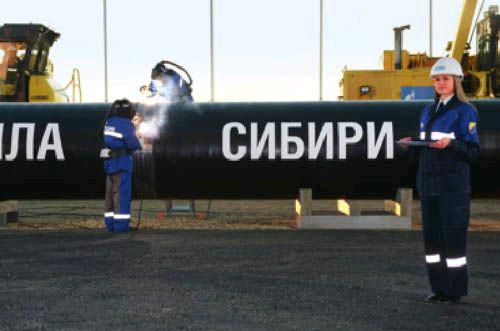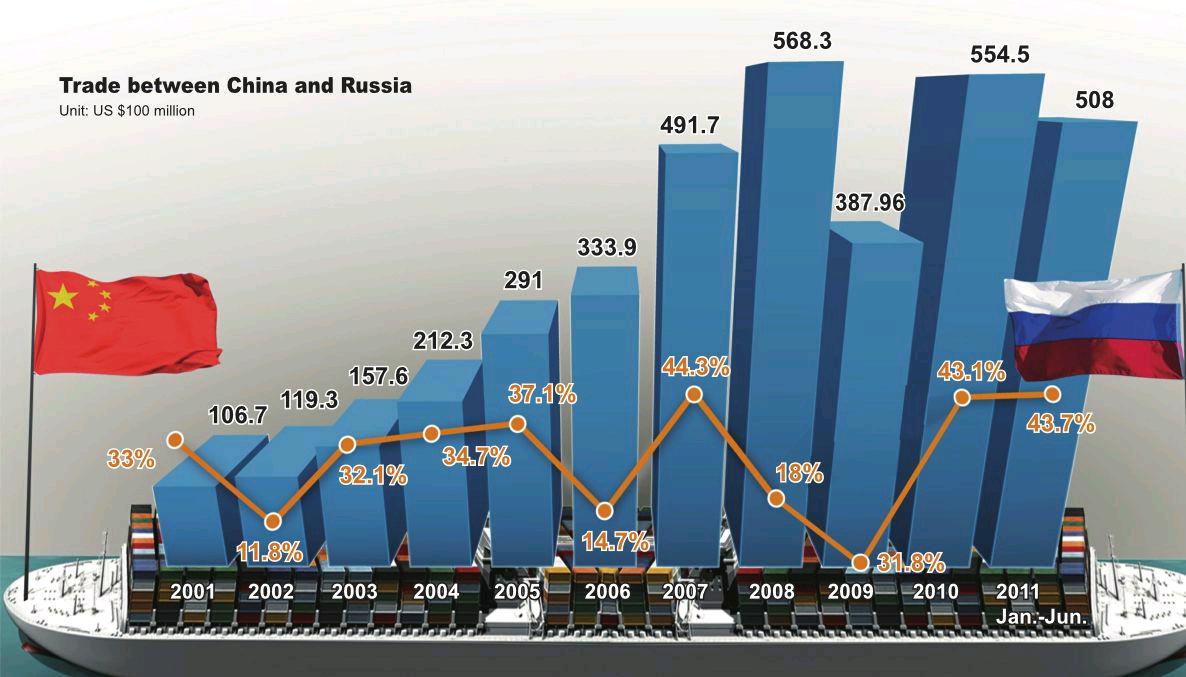APEC–A Boost for Sino-Russian Economic Cooperation
2014-12-20ByLIJIANMIN
By+LI+JIANMIN
Opportunities for Both Countries
APEC follows a pattern of marketdriven regional economic integration. Its goals are to sustain economic growth, increase interdependence of economies in the region, enhance an open multilateral trade system, reduce barriers to cross-regional trade and investment, and defend the common interests of all peoples in the area. The organization has made solid progress in advancing free trade and investment and economic and technological cooperation in the Asia-Pacific and worldwide, contributing to regional trade and investment growth and economic prosperity.
The economic cooperation between China and Russia, two regional powers, is of great significance to the AsiaPacific. And APEC proffers them a key conduit to participate in economic globalization and regional economic integration, as well as to propel their respective reforms, opening-up and economic development.
China and Russia are both in transition. Since their admission to APEC, they have gradually become conversant with the rules of regional and international multilateral cooperation, learned from other member countries successful experience in management of the economic system, and accordingly ameliorated their own market systems. Membership in APEC prepared China and Russia for their later entry into the WTO and created external conditions for their accession. In 2001 and 2011, 10 and 13 years respectively after their joining APEC, China and Russia became members of the WTO.
Within the APEC framework both countries have substantively benefited in such areas as government procurement, management of international e-commerce and customs procedures. APEC is the first multilateral platform that China acceded to and is a key channel for Russia to get involved in the Asia-Pacific. In their applications for membership they made multiple promises such as those concerning market access conditions. Admission entitled them to a spectrum of opportunities and rewards, including tariff reduction, removal of non-tariff barriers, mutual open markets, more exports of commodities and greater competitiveness. The Asia-Pacific is now a critical region for both countries foreign economy.
Last year the trade volume with other APEC members accounted for 60 percent of Chinas total international trade; as much as 83 percent of the actual inflow of foreign investment came from APEC countries, and 69 percent of Chinas outbound direct investment destined for APEC countries. Among Chinas top 10 trade partners eight are APEC members, testifying to the close economic ties within the regional organization.
Although two thirds of its territory lies in Asia, Russia has traditionally positioned its political, economic and cultural epicenters in Europe. But it has begun to tilt eastward over recent years.
Its investment in the Asia-Pacific is not remarkable yet, but trade with the region has increased dramatically. From 2001 to 2006 its trade volume with APEC tripled from US $85.3 billion to US $259.1 billion; the share of exports to the Asia-Pacific in its total exports rose from 14 percent to 17.3 percent, and that for imports from the region grew from 23.1 percent to 30.2 percent. During the 2008-2013 period APEC became Russias second largest trade partner, next only to the EU, and its share in Russias foreign trade expanded from under 20 percent to 23.9 percent.
Since Russia joined APEC in 1998, bilateral trade with China has been rising steadily, reaching US $89.2 billion in 2013, 15 times more than the 1998 figure, and accounts for 47 percent of its total trade with APEC (3.5 percent of Chinas total trade with the organization). The economic interdependence between the two countries has been growing: China is Russias No. 1 trade partner within APEC and globally, and Russias fourth largest source of foreign investment. Russia, meanwhile, is Chinas fourth largest energy supplier.
APEC Gains in Sino-Russian Cooperation
APEC opens up new opportunities for the development of economic ties between China and Russia. The active endeavors of the two countries in promoting a regional integration pattern that is multi-layered and multifaceted are constructive in the development of APEC.
Since joining APEC, China and Russia have participated in all of its summit meetings and put forward many affirmative proposals. As the worlds second largest economy and largest source of commodity trade, China is exerting growing influence in APEC, which it uses to rally members to comprehensively propel regional cooperation in the AsiaPacific.
In the 1997 Asian financial crisis and the 2008 global financial crisis China acted as a responsible major country, adopting prudent monetary policies and proactive fiscal policies to stimulate domestic demand and bolster stable, healthy growth of its economy. These efforts helped stabilize regional and international finance, offered relief to the economic plights of Asia and the whole world, and gave strong impetus to the recovery of Asian and world economy.
China has so far signed agreements for free trade zones with 10 countries, several of them APEC members. This progress counters trade protectionism and facilitates free trade and investment flow regionally and internationally. Further opening up of Chinas market also allows other countries to share the fruits of its robust economic growth.
As its eastern regions are largely undeveloped, Russia so far plays a limited role in the Asia-Pacific that is incommensurate with its huge potential. But its relative lack of sway now does not mean it will remain so in the future. Diplomacy with the Asia-Pacific is a priority in President Putins foreign policies during his third term. Therefore, it is expected that Russia will become more involved in Asia-Pacific integration.
In September 2012 Vladivostok in eastern Russia hosted APECs 20th Economic Leaders Meeting, the first time an APEC summit was held in Russian territory. The event signified the importance Russia apportions to the Far East, its willingness to cooperate with Asia- Pacific countries as well its strategic plan of returning to the region. State leaders discussed at the meeting trade and investment liberalization, regional economic integration, strengthening food security and establishing reliable supply chains, as well as cooperation to foster innovative growth. Through these subjects Russia aims to enhance acrossthe-board cooperation with Asia-Pacific countries so as to engage itself more thoroughly with the region.
The largest regional organization in the Asia-Pacific, APEC is not only about promoting trade and economic coopera- tion. It has substantial potential in facilitating technological cooperation, social/ cultural exchanges and cooperation in non-conventional security areas among member states.
China and Russia have broad common interests and concerns in the AsiaPacific. But their bilateral trade at present has a modest share in total crossborder trade in APEC. China and Russia are two regional powers, but the former is more distinguished by economic strength, the latter by military might. Given the current status of Russias economic clout, security and strategic presence will be the core means of its maintaining regional influence over a long period of time.
From a long-term perspective Russia is projected to advance to its utmost in Asia-Pacific economic integration. Cooperation between two world major countries – China and Russia – is in the interests of both parties and also the regions in which they are located. It is hence conducive to the improvement of global governance and fair handling of international affairs. China and Russia, therefore, have to position their cooperation in light of their respective strategic needs, in bilateral cooperation, their strategic roles in regional cooperation as well as their strategic functions on the platform of global governance. The new world situation requires the two countries to shoulder due responsibility for world peace, stability and development. They are expected to play dual roles in the Asia-Pacific: first, as defenders of the regions security, and second, as spearheads and stewards of cooperation across this area.
Realms of Future Cooperation
The comprehensive strategic partnership between China and Russia is a major positive factor for peace, security and development of the Asia-Pacific; their cooperation will bolster collaboration across the area.
Future Sino-Russian cooperation within the APEC framework will focus on the following fields. First, energy. It is a long-term goal of APEC to enhance regional cooperation on this issue, ensuring sustainable growth of the energy industry and better defense of energy security. China and Russia have agreed to establish a comprehensive energy cooperation partnership and deepen a package of cooperation in the oil sector. Russia has vowed to start supplying gas to China as soon as possible. And the two countries will enhance cooperation in coal by exploring coal mines and developing the transportation network in Russia. They will also study the construction of new power generation facilities in Russia and increase power exports to China.
Second, interconnectivity. To improve infrastructure in the region to increase interconnectivity has been a priority of APEC since 2013. Russia responded positively to Chinas proposal of building the New Silk Road Economic Belt, and has expressed its desire to make the Eurasian railway part of the plan for the new trade route, seeking compatibility between this project and the envisioned Eurasian economic alliance. China and Russia will accelerate construction of cross-border transport infrastructure in the Asia-Pacific region, improving the transport conditions of Chinese cargo through Russias railway network, Far East ports and northern sailing routes. The projects include the railway bridge between Tongjiang Port in northeast Chinas Heilongjiang Province and Russias Nizhneleninskoye, highway bridges between Chinas Heihe and Russias Blagoveshchensk, Dongning and Poltavka, and between Luoguhe and Pokrovka, as well as a cableway between Heihe and Blagoveshchensk. Better interconnectivity realized through more cross-border networks will ramp up Sino-Russian trade and economic cooperation to a higher level and also lend impetus to the development of the entire APEC area.
Third, agriculture. Safeguarding food security through better regional cooperation is a key cooperative area of APEC. The agricultural sectors of China and Russia are supplementary, and their cooperation has bright prospects. Marked progress has been made in mutual investment and industrial upgrading in this regard. The Ukraine crisis and the sanctions and counter-sanctions between Russia and Western countries have opened up new opportunities for agricultural cooperation between China and Russia, which are expected to focus on trade in farm products, agricultural exploration abroad, cooperation on agricultural labor, and technological exchanges.
Fourth, finance. China and Russia see a solid foundation for financial cooperation within the APEC framework. Due to confrontation between Russia and the U.S. in the wake of the Ukraine crisis, Russia is more determined to quit the dollar system. China and Russia will, therefore, conduct closer collaboration in the financial sector, including extending the scale of local currency settlements in bilateral trade, investment and lending so as to better shield the two countries from fluctuations in exchange rates of the worlds major currencies. Russias VTB Capital has signed an agreement with the Bank of China to develop their partnership in a number of areas including cooperation on ruble and Renminbi settlements, investment banking, interbank lending, trade finance and capitalmarkets transactions. At present 75 percent of cross-border trade between the two countries is settled in U.S. dollars. Currency swapping can lower financing and exchange costs by a big margin for both sides and bring substantial benefits to their businesses.
